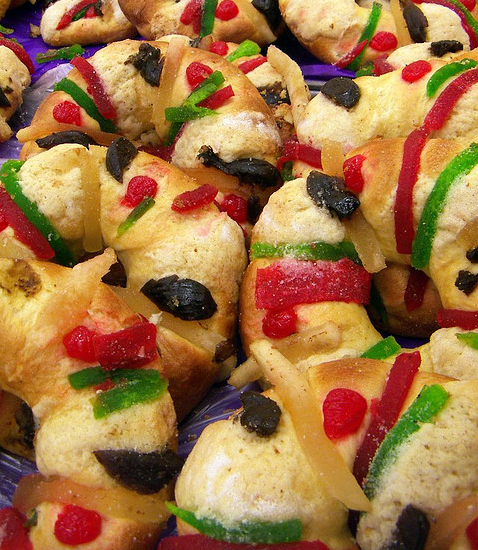It is a common tradition among Mexicans to get together with their families on January 6th and eat a special cake called “Rosca de Reyes” (translated as “King's Cake”). Whoever finds a small plastic doll inside their piece of cake will have to buy Mexican food for everybody on February 2nd. Several bloggers have written about this tradition, what it means and how it is celebrated.
The blog One Lucky Life describes the tradition of the “King's Cake”: [1]
The tradition of the famous “king’s cake” with the family is something I remember since I was a young girl. I would get anxious, as I wanted to see the little plastic doll inside my piece of cake. For those who might not be familiar with this tradition, I will explain it briefly:
In Mexico, on each January 6th, families get together and cut the famous “Rosca de Reyes”(Literally King’s Cake) , which is a large ring-shaped cake/bread roll decorated with crystallized fruit and sugar. Inside the cake you will find mini plastic dolls representing Jesus Christ. Each member of the family cuts a piece of the cake, and if you a doll inside your piece, on February 2nd you will have to invite tamales [2] to your family!
Mike Gonzales, in the blog New Santa Ana, tells readers why there are plastic dolls [3]representing Jesus Christ inside the cake:
The tradition of placing a trinket (figurine of the Christ Child) in the cake is very old. The baby Jesus, when hidden in the bread, represents the flight of Jesus, fleeing from King Herod’s evil plan to kill all babies that could be the prophesied messiah. Whoever finds the baby Jesus figurine is blessed and must take the figurine to the nearest church on February 2, Candlemas Day (Día de la Candelaria). In the Mexican culture, this person also has to throw a party and provide tamales and atole to the guests.
In the blog Nibbles and Feasts, [4] blogger Ericka explains why the person who gets the plastic doll must treat others to Mexican food on February 2nd:
According to tradition whoever finds the little doll in their slice of sweet bread must give a party on February 2nd, Candlemas Day or Dia de la Candelaria, offering tamales, hot chocolate and atole to their guests. Candlemas is the day that Mary presented the infant Jesus to the temple and is traditionally the day that candles are blessed in the Catholic Church.
 [5]
[5]Typical "Rosca de Reyes" from Mexico image by Flickr user A30_Tsitika used under a Creative Commons Attribution-Share Alike license
The King's Cake recipe can be found at Nibbles and Feasts [4].
Finally, in 2008, American blogger Joy wrote about the “King's Cake” tradition [6] from a foreigner's point of view:
OK, so a Rosca de Reyes [7] cake is really not very strange, it’s just new to me. This weekend is a festive time in Mexico (long-time readers: You’re learning it’s always a festive time here, aren’t you?) because Jan. 6. is King’s Day (Dia de Reyes), also known as Epiphany. It’s traditionally when Mexican children are given their gifts. One way of celebrating this time of year is to serve a Rosca de Reyes. (Mexico City also serves up a “mega-rosca” and throws a parade.)
The cake is very similar in taste and appearance to a King’s Cake of the Mardi Gras tradition — there’s even little baby Jesuses in the cake. (Note: I got the first baby Jesus, which means I have to invite Brendan over to my house later this month and serve tamales. But there are apparently numerous Jesuses in one cake.)